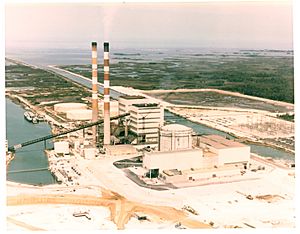Crystal River Nuclear Plant facts for kids
Quick facts for kids Crystal River Nuclear Plant |
|
|---|---|

Aerial of Crystal River Nuclear Plant
|
|
| Country | United States |
| Location | Crystal River, Florida |
| Coordinates | 28°57.45′N 82°41.90′W / 28.95750°N 82.69833°W |
| Status | B |
| Construction began | September 25, 1968 |
| Commission date | March 13, 1977 |
| Construction cost | $1.436 billion (2007) |
| Owner(s) | Duke Energy |
The Crystal River Nuclear Plant, also called CR-3, was a nuclear power plant located in Crystal River, Florida. It was a special kind of power plant that used nuclear energy to make electricity. The plant started making power in 1977 and worked safely for 33 years. It was shut down in 2009 and then permanently closed in 2013.
The Crystal River Nuclear Plant was part of a bigger area called the Crystal River Energy Complex. This complex covers about 4,700 acres. Besides the nuclear plant, there are also four power plants that use fossil fuels like coal. The nuclear plant is now being taken apart safely, a process called SAFSTOR.
The Crystal River plant was first owned by Florida Progress Corporation. Later, in 2000, it was bought by Carolina Power & Light. This company then became Progress Energy. In 2012, Duke Energy bought Progress Energy. So, Duke Energy became the owner of the Crystal River Nuclear Plant.
Contents
How the Plant Worked
The Crystal River 3 Nuclear Power Plant used a type of reactor called a PWR, which stands for pressurized water reactor. It could produce 860 megawatts of electricity.
Protecting the Public
Nuclear power plants have important safety features. One key safety barrier is the containment building. This strong building holds the nuclear fuel, the reactor, and the cooling system. It is designed to keep any radiation safely inside.
The Crystal River containment building was a large, round concrete structure. It was about 157 feet tall and 138 feet wide. Its walls were very thick, about 42 inches. These walls were made stronger with special steel cables called tendons. These tendons helped the concrete stay together and be very strong.
Why the Plant Closed
In September 2009, the Crystal River plant was shut down for a short time. This was for regular maintenance and to replace some parts called steam generators. To do this work, a large opening needed to be made in the containment building wall.
Problems During Repairs
To make the opening, some of the steel cables (tendons) in the wall had to be loosened. During this work, engineers found a large gap in the concrete wall. This problem is called "delamination." It means layers of concrete had separated.
Workers tried to fix this gap. But then, more delamination started to appear in other parts of the wall. This made the repairs much harder and more expensive than expected.
Decision to Close Permanently
The plant was supposed to restart in 2011, but the repairs took much longer. After looking at all the options, Duke Energy decided in February 2013 to close the Crystal River Nuclear Plant for good. The coal-fired power plants at the same site were not affected and are still running.
Some experts, like Gregory Jaczko, a former chairman of the Nuclear Regulatory Commission, said the plant closed because of mistakes in planning the repair work. However, Duke Energy said that the cracking could not have been predicted. The U.S. Nuclear Regulatory Commission agreed with Duke Energy's findings.
People Living Nearby
Nuclear power plants have special safety zones around them. These zones help plan for emergencies.
Emergency Planning Zones
- Plume Exposure Pathway Zone: This zone is about 10 miles around the plant. It focuses on protecting people from breathing in radioactive material if there's an accident.
- Ingestion Pathway Zone: This zone is about 50 miles around the plant. It focuses on making sure food and water are safe from contamination.
In 2010, about 20,695 people lived within 10 miles of Crystal River. This was a big increase from ten years before. About 1,046,741 people lived within 50 miles. Some cities within 50 miles include Ocala and Spring Hill.
Earthquake Risk
On September 10, 2006, a magnitude 5.8 earthquake happened about 300 miles southwest of the plant. The Crystal River Nuclear Plant was not damaged by this earthquake. Experts say the chance of another strong earthquake happening near Florida soon is very low.
The Nuclear Regulatory Commission (NRC) studied the risk of an earthquake strong enough to damage the reactor at Crystal River. Their study in 2010 estimated this risk to be about 1 in 45,455 each year. This means it is very unlikely to happen.
See also
 In Spanish: Central Nuclear de Crystal River para niños
In Spanish: Central Nuclear de Crystal River para niños

